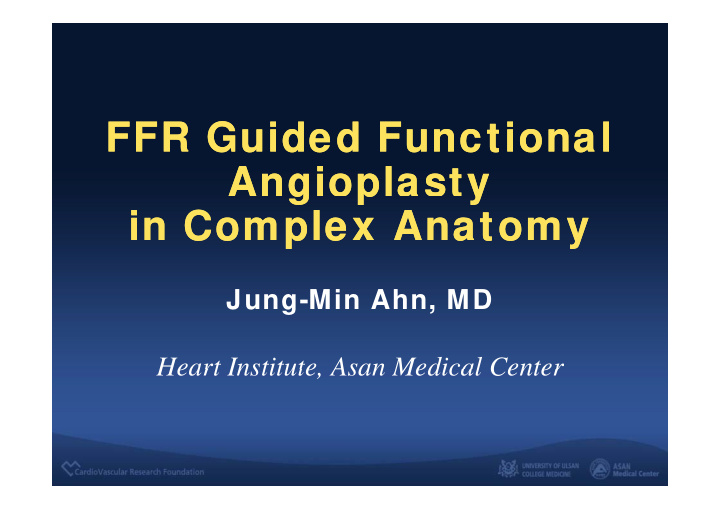



FFR Guided Functional FFR Guided Functional FFR Guided Functional FFR Guided Functional Angioplasty Angioplasty g g p p y y in Complex Anatomy in Complex Anatomy Jung-Min Ahn, MD g , Heart Institute Asan Medical Center Heart Institute, Asan Medical Center
Case 1. Case 1. Case 1. Case 1. • 45yo/M • 45yo/M • Chest pain for 4 months • Chest pain for 4 months • Risk factors : DM HTN ex smoking • Risk factors : DM, HTN, ex-smoking C Coronary CT at other hospital CT t th h it l
Coronary Angiogram Coronary Angiogram Coronary Angiogram Coronary Angiogram
Coronary Angiogram Coronary Angiogram Coronary Angiogram Coronary Angiogram
Coronary Angiogram Coronary Angiogram Coronary Angiogram Coronary Angiogram
Result of CAG Result of CAG Result of CAG Result of CAG • Angiographic multivessel disease (2 V (2 Vessel Disease) l Di ) • Really same findings with coronary CT y g y • How to treat this patient ?? How to treat this patient ?? Just Stent it ?
FFR & IVUS FFR & IVUS FFR & IVUS FFR & IVUS FFR : 0.84 IVUS 3.3 mm 2
IVUS & FFR IVUS & FFR IVUS & FFR IVUS & FFR FFR : 0.86 Angiographic 2 Vessel Disease Angiographic 2 Vessel Disease But, Functionally Normal Cornary IVUS 2.2 mm 2
Visual-Functional Mismatch Visual-Functional Mismatch From FAME Study Functionally Diseased Coronary Arteries C 0VD (34%) 2VD (14%) 1VD (43%) ( ) Angiographic 2VD J Am Coll Cardiol 2010;55:2816–21
Non-Invasive functional study Non-Invasive functional study Non Invasive functional study Non Invasive functional study • Thallium SPECT : WNL • Thallium SPECT : WNL • TMT : Stage 4 HR 173 (97% of Target HR) • TMT : Stage 4, HR 173 (97% of Target HR)
Case 2. Case 2. Case 2. Case 2. • 62yo/M • 62yo/M • Recurrent Chest pain for 1 year • Recurrent Chest pain for 1 year • Risk factors : None • Risk factors : None
Coronary Angiogram Coronary Angiogram Coronary Angiogram Coronary Angiogram LAD FFR 0.71 0.71
How to Treat? How to Treat? How to Treat? How to Treat? • Simple cross over ? • Two stent technique ? T t t t h i ? • Side branch protection ? p
Procedure Procedure Procedure Procedure BMW in 1 st Di & predilatation predilatation Promus Element 4.0(28) Promus Element 3.5(12)
After Stent at Main Vessel After Stent at Main Vessel After Stent at Main Vessel After Stent at Main Vessel
What Would You Do? What Would You Do? What Would You Do? What Would You Do? FFR 0 84 FFR 0.84 Leave it alone.
FFR of the Jailed Side Branch FFR of the Jailed Side Branch J J S S c c 1.0 rve 0.9 ow Reser 0.8 ional Flo 0.7 Only 27% Fracti among SB 0.6 r=-0.464, p<0.001 with > 75% has FFR < 0.75 0.5 40 50 60 70 80 90 100 Percent Stenosis (%) Percent Stenosis (%) Koo BK et al JACC 2005; 46: 633
Case 3. Case 3. Case 3. Case 3. • 47yo/M • 47yo/M • Recent onset chest pain • Recent onset chest pain • Risk factors : HTN • Risk factors : HTN
Coronary Angiogram Coronary Angiogram Coronary Angiogram Coronary Angiogram
Coronary Angiogram Coronary Angiogram Coronary Angiogram Coronary Angiogram
IVUS & FFR IVUS & FFR IVUS & FFR IVUS & FFR FFR : 0.84 FFR : 0.84 IVUS IVUS 4.8 mm 2
FFR of the Equivocal LMCA FFR of the Equivocal LMCA q “Mismatch” is 29% in equivocal LMCA 80 sis Stenos 60 eter S 40 v v Diame 20 % D R= 0 38 p<0 01 R=-0.38, p<0.01 0 1.0 0.5 0.6 0.7 0.8 0.9 FFR Isolated LMCA disease Circulation 2009;120:1505-1512
FFR guided PCI in Equivocal LMCA FFR guided PCI in Equivocal LMCA • In 213 patients with an equivocal LMCA stenosis • FFR ≥ 0 80: DEFER (n=138) vs FFR<0 80: CABG (n=75) • FFR ≥ 0.80: DEFER (n=138) vs. FFR<0.80: CABG (n=75) 100 100 100 100 89.8% 82.8% 80 80 85.4% ee p=0 48 p=0.48 p=0.5 p=0 5 74 2% 74.2% % MACE fre % Survival 60 60 FFR ≥ 0.80 FFR ≥ 0.80 FFR<0.80 FFR<0.80 40 40 % % 20 Survival MACE 20 0 12 24 36 48 60 0 12 24 36 48 60 Months Months An FFR-guided strategy show ed the favorable outcome. Circulation. 2009;120:1505-1512
How to Treat How to Treat Angiographic multivessel disease Functionally Functionally, Normal coronary artery We just used 2 stents, simple cross over to p treat these lesion Angiographic Jailed Side branch subset including g multivessel, bifurcation, and LM , disease Angiographic Isolated LM dz All of them are still alive All of them are still alive
Summary Summary Summary Summary • If you measured FFR in complex lesion subset, you could find the simple functional anatomy from complex angiographic findings anatomy from complex angiographic findings • Therefore FFR measurement makes Therefore, FFR measurement makes treatment simplified p
“Simple” “Simple” is the ultimate sophistication... is the ultimate sophistication... i th lti i th lti t t hi ti hi ti ti ti Leonardo Da Vinci said 0 80 0.80 Just FFR it Just FFR it DEFER PCI
FFR measurement in Complex FFR measurement in Complex s s C C p p lesions may lead to lesions may lead to ① S ① Save stent and cost t t d t ② Avoid unnecessary PCI ③ Improve clinical outcomes of patients
Recommend
More recommend